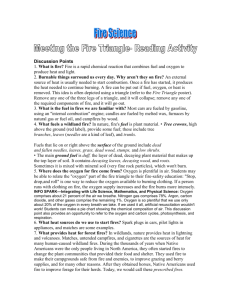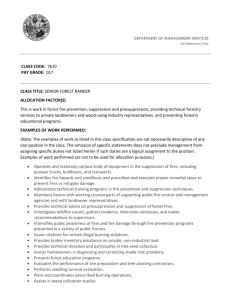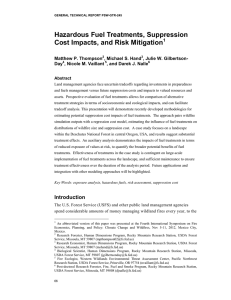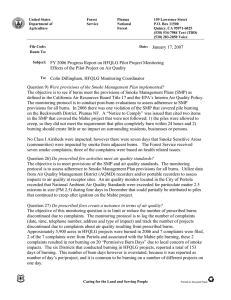Document 10605811
advertisement
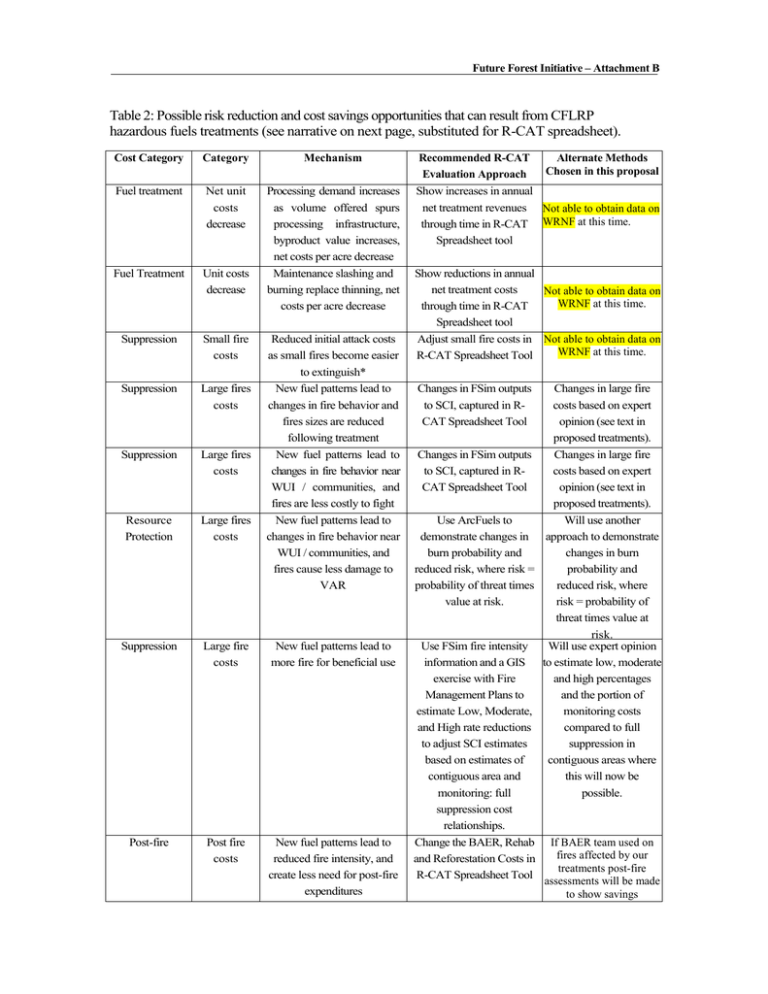
Future Forest Initiative – Attachment B Table 2: Possible risk reduction and cost savings opportunities that can result from CFLRP hazardous fuels treatments (see narrative on next page, substituted for R-CAT spreadsheet). Cost Category Category Mechanism Fuel treatment Net unit costs decrease Fuel Treatment Unit costs decrease Processing demand increases as volume offered spurs processing infrastructure, byproduct value increases, net costs per acre decrease Maintenance slashing and burning replace thinning, net costs per acre decrease Suppression Small fire costs Suppression Large fires costs Suppression Large fires costs Resource Protection Large fires costs Suppression Large fire costs New fuel patterns lead to more fire for beneficial use Post-fire Post fire costs New fuel patterns lead to reduced fire intensity, and create less need for post-fire expenditures Reduced initial attack costs as small fires become easier to extinguish* New fuel patterns lead to changes in fire behavior and fires sizes are reduced following treatment New fuel patterns lead to changes in fire behavior near WUI / communities, and fires are less costly to fight New fuel patterns lead to changes in fire behavior near WUI / communities, and fires cause less damage to VAR Alternate Methods Recommended R-CAT Chosen in this proposal Evaluation Approach Show increases in annual net treatment revenues Not able to obtain data on through time in R-CAT WRNF at this time. Spreadsheet tool Show reductions in annual net treatment costs Not able to obtain data on WRNF at this time. through time in R-CAT Spreadsheet tool Adjust small fire costs in Not able to obtain data on WRNF at this time. R-CAT Spreadsheet Tool Changes in FSim outputs to SCI, captured in RCAT Spreadsheet Tool Changes in FSim outputs to SCI, captured in RCAT Spreadsheet Tool Use ArcFuels to demonstrate changes in burn probability and reduced risk, where risk = probability of threat times value at risk. Use FSim fire intensity information and a GIS exercise with Fire Management Plans to estimate Low, Moderate, and High rate reductions to adjust SCI estimates based on estimates of contiguous area and monitoring: full suppression cost relationships. Change the BAER, Rehab and Reforestation Costs in R-CAT Spreadsheet Tool Changes in large fire costs based on expert opinion (see text in proposed treatments). Changes in large fire costs based on expert opinion (see text in proposed treatments). Will use another approach to demonstrate changes in burn probability and reduced risk, where risk = probability of threat times value at risk. Will use expert opinion to estimate low, moderate and high percentages and the portion of monitoring costs compared to full suppression in contiguous areas where this will now be possible. If BAER team used on fires affected by our treatments post-fire assessments will be made to show savings Future Forest Initiative – Attachment B Wildfire Savings Current vegetation conditions within the proposed area are directly in alignment for catastrophic wildfires that could threaten and destroy communities. Property values are some of the highest in the continental United States including Aspen and Carbondale just to mention a few. Several regional and national Wildland Fire Decision Support System (WFDSS) training scenarios have used Stratified Cost Index (SCI) on fires within the Aspen/Sopris District boundaries (within the Roaring Fork Watershed) with estimated cost exceeding 3 billion dollars for property value loss. Our forest health has changed drastically and is continuing to deteriorate from Mountain Bark Beetle infestations and other natural late successional related diseases. Our Lodgepole Pine historically has 150-200 year fire return interval which currently due to disease is available to burn now at around 100 years. Tom Harbor Washington Office Fire and Aviation Chief recently addressed Region 2 Fire management officers in Lakewood, Colorado stating, “the White River National Forest (WRNF) ecosystem has low frequency fire occurrence with high catastrophic potential.” The 4-Mile Fire in Boulder, Colorado in the late summer of 2010 burned 6,181 acres destroying 167 structures damaged 14 others with an estimated cost upwards of 10 million dollars before litigation. To restore these mid to high elevation montane ecosystems systems and potentially stop catastrophic wildfire potential a series of strategic large scale fuel treatments need to occur. Treatments need to break up fuel continuity in forest to reduce crown fire potential in canopies. These fuels projects if funded will allow lower intensity Multiple Management Objective fires to be managed at substantially reduced cost and lower risk to firefighters and the public’s living adjacent to the forest lands. Prescribed Burns will be safer and more viable with thinning treatments and potential for escape RX burns reduced significantly. Another key component is Community Wildfire Protection Plans (CWPP) which reduce fuel loading around and within communities surrounding National Forest System (NFS) lands. The Unite States Forest Service (USFS) and other federal agencies utilize the CWPPs to prioritize treatments on their lands. Communities have partnered with the USFS and other federal agencies to begin active fuels restoration and mitigation treatments that dovetail nicely with proposed grant treatments. How Wildfires will be Managed. The WRNF Land Management Plan and Fire Management Plan identify resource objectives for the management of naturally ignited wildfires on the forest. Whenever possible, wildland fires will be used to: 1) reduce hazardous fuels to protect life and property; 2) improve overall forest health and enhance ecosystem function and enhance wildlife habitat, species diversity, and range and watershed conditions; and 3) reduce the potential for large catastrophic fires by helping to return the forest to more historic fuel types and conditions. The proposed fuels treatments will allow the WRNF to more effectively and safely manage all fires whether in the Wildland Urban Interface (WUI) or larger landscape Multiple Management Objective (MMO) fires. MMO fires greatly reduce fire cost and allow land managers the ability to return fire back into the ecosystem saving hundreds of thousands of tax payers’ dollars. Long term suppression cost savings could be as high as 80 percent (less) with proposed fuel treatments in place prior to any escalating catastrophic wildfire. Note: The costs of managing wildfires in the Roaring Fork Valley as obtained from fire managers on the Upper Colorado River Interagency Fire Management Unit vary from $50 to $1600/acre. After the restoration projects in this grant, long-term management costs for follow-up Rx burning and mechanical treatments should be significantly reduced to $50- $200/acre. These figures reflect over 150 years of fire experience from the fire managers who know this area well.


